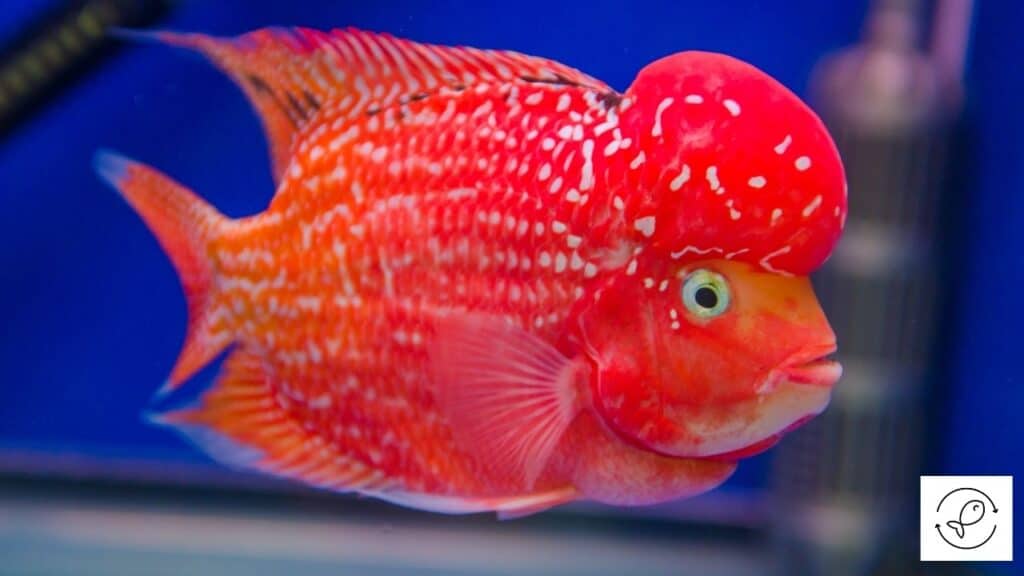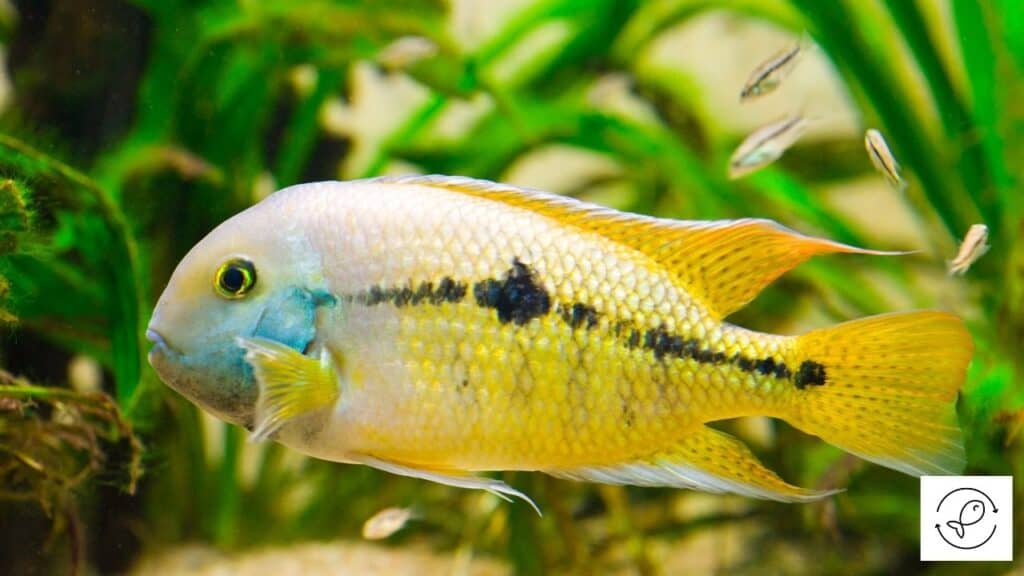Cichlids can’t eat tropical fish food. They need a well-balanced diet to thrive. Cichlids lose their colors and vibrancy if you feed them a poor diet. That’s why you need to feed your cichlids fish food rich in proteins, vitamins, minerals, and fats to enhance their colors and overall health.
Let’s now understand why cichlids shouldn’t eat tropical fish food in more detail.
Why Shouldn’t Cichlids Eat Tropical Fish Food?
Cichlids are one of the most popular freshwater aquarium fish. Their stunning colors and varied patterns are captivating.
There’s also a variety of cichlid species available to choose from for your aquariums.
Tropical fish food is an excellent source of nutrients for cichlids.
But it contains high levels of carbohydrates which cichlids do not need as they can’t digest carbohydrates efficiently.
However, carbohydrates are present in pellets, flakes, and other food items to bind them together.
So eating carb-induced food can lead to bloating or gastrointestinal problems in cichlids.
Similarly, tropical fish food also contains grains that serve as binders.
Although cichlids can synthesize lipids and proteins, too much gets stored as fat.
This increases the expulsion of undigested waste by the cichlids, which can quickly spike the ammonia levels and lead to pollution in the aquarium water.
So it’s necessary to provide cichlids with a completely balanced diet.
It will help enhance their colors, make them active and energetic, and improve their overall health and growth.
What Do Cichlids Eat In The Wild?
In the wild, cichlids eat various food depending on their habitat and dietary group – herbivores, carnivores, and omnivores.
Given below are the foods that cichlids eat in the wild.
1. Herbivore Cichlids
Herbivorous cichlids feed on plant matter.
Their primary diet consists of algae, biofilm, and plants.
Examples of herbivores are Mbuna Cichlids, Pearlspot Cichlid, Tropheus Cichlids, etc.
Herbivores don’t eat protein-rich foods.
Their digestive tracts are designed to absorb nutrients from foods but not to break down proteins. This causes bloating in cichlids.
2. Carnivore Cichlids
Carnivorous cichlids feed on small wildlife and other fish.
Their primary diet consists of small fish, bloodworms, crustaceans, invertebrates, planktons, and insects.
Some examples of carnivore cichlids are Fromtosa Cichlids, Jaguar Cichlids, Wolf Cichlids, etc.
Carnivores eat protein-rich foods as their digestive tract can easily break down fats and proteins.
3. Omnivore Cichlids
Omnivorous cichlids feed on both plants and small fish.
Most cichlid species are omnivores and devour everything consumed by the herbivore and carnivore cichlids.
Some examples of omnivore cichlids are Firemouth Cichlids, Peacock Cichlids, Rusty Cichlids, etc.
Omnivore cichlids’ digestive tracts are better than carnivores and can comfortably digest most food types.
What To Consider When Buying Cichlid Food?
When buying food for your cichlids, there’s no one-size-fits-all solution.
In other words, you can’t feed the same food to different cichlid species.
The food you consider best for one species will be useless for others.
Besides, you must also consider the fish needs to understand if a specific food aids or impacts their health.
Below are the things to consider before buying food for cichlids.
1. Dietary Types
The food you select for your pet cichlids should match their dietary group.
Herbivore cichlids need plant matter in their diet. Feeding them insects or larvae will probably scare them.
They need nutrients, but feeding protein-rich food will cause bloating and health issues.
Similarly, you can’t feed algae and plants to carnivore cichlids.
They need small fish, bloodworms, etc., in their diet to get the proteins needed for growth and healthy development.
Omnivore cichlids are easy to feed because they eat meat as well as plants.
Although this looks easy, it’s essential to get the right balance for the cichlids to thrive.
2. Nutrient Requirements
Your knowledge about the optimum protein levels needed by your fish is necessary to formulate a nutritionally balanced, low-cost diet.
A good quality meal must include proteins that provide fish with the essential amino acids.
Their diet must also include fats (for energy and as sources of essential fatty acids), vitamins, and minerals to improve their overall health and keep them strong, active, and energetic.
3. Color Boosters

Color or pigment boosters are products that contain carotenoid ingredients to enhance the natural color of the fish.
It’s an organic compound found in fruits and veggies that gives them their color.
However, you don’t have to feed the color-enhancing fish foods to your fish. You can enhance their colors by providing a proper diet.
It’s also essential to know that food products that enhance fish color don’t usually make the fish healthy.
So choose a diet based on the wild feeding habits of your fish and don’t rely entirely on color boosters to achieve bright coloration.
4. Fiber
Fiber has different purposes, including helping certain fish have more time for processing food and absorbing the things they need.
It also helps to prevent constipation.
However, it’s important to understand that fiber is essential and must be included in some food items.
In the case of herbivore cichlids, it’s necessary to include the right amount of fiber in their diet.
However, fiber doesn’t contain any nutrients or vitamins.
So don’t give too much fiber to your carnivore cichlids or too little to your herbivore cichlids as it can adversely impact their health.
5. Fillers
Filler food items for fish are equivalent to burgers, fries, and soda for humans.
They have no nutritional value but can affect cichlids’ digestive tract and health.
So stay away from fillers to ensure your cichlids are fed food containing proper nutrition.
Avoiding fillers will also help maintain the overall health of your cichlids.
Let’s now understand what to feed cichlids at home in more detail.
What To Feed Cichlids At Home?
Before deciding the food for your cichlids, the most crucial part is understanding their nutrition requirements.
Once you know about their dietary requirements, you can plan the diet accordingly.
Given below are different food options that you can feed cichlids at home.
1. Manufactured Foods
Manufactured foods are the cheapest option for aquarists.
These foods are typically dry and come with added color boosters to enhance your cichlids’ natural colors.
- Fish Flakes: Flakes are an excellent food option and popular for cichlids. They are pieces of fish food crushed into a thin layer. However, flakes are not viable for bottom-feeders because they dissolve mid-water.
- Fish Pellets: Pellets have more nutritional content than fish flakes. These are small capsules with a mixture of ingredients. They are made by keeping in mind cichlids’ requirements. There are floating pellets and sinking pellets. The former is best suited for top feeders and the latter for mid-tank and bottom dwellers.
- Fish Tablets: Tablets are made using ingredients that offer vital vitamins and other nutrients that improve cichlids’ health. Attaching the stick-on tablet to the aquarium wall helps the fish that occupy the middle tank level. However, allow some tablets to sink to the bottom of the tank so that the bottom dwellers can also get a healthy meal.
- Algae Wafers: Algae wafers are best for providing veggies to cichlids. Make sure you find one that contains spirulina.
Manufactured fish foods are usually affordable, and you can make them a part of the cichlids’ daily diet.
2. Fresh, Frozen, And Live Foods
This is the second most common type of food used by many fishkeepers.
You can buy fresh food from local shops, online stores, or even from your backyard.
You can choose between live foods and frozen foods. Frozen foods are generally cheaper than live foods.
However, live foods are healthier for fish.
- Frozen Food: Frozen food includes worms, shrimp, crabs, lobsters, larvae, etc. They are a good source of proteins and are often fortified with multivitamins to promote good health. Don’t re-freeze the food and keep it at room temperature before serving it to your cichlids.
- Live Food: Live food is protein-rich and will benefit your cichlids. Live food is expensive, and it’s difficult to find the right type of food. Most people breed their live fish foods such as worms, bloodworms, brine shrimp, larvae, etc. It takes a lot of effort but can help in reducing the fish food cost exponentially.
3. Vegetables
Vegetables are also an excellent food source for your cichlids.
Veggies like broccoli, spinach, zucchini, squash, cucumbers, or peas are excellent snacks for your fish.
Some species of cichlids are herbivorous and feed on algae and plants. So they enjoy eating vegetables.
However, remember that most vegetables are a heavy meal for your fish and may cause them to bloat.
4. Fruits
Some cichlids species are herbivores or omnivores.
So you can occasionally feed them fresh fruits like strawberries, blueberries, and grapes.
How Frequently Should You Feed Your Cichlids?
You should feed your cichlids little, but often.
Typically, you must feed a small quantity of food two to three times a day that the cichlids can eat within a few minutes.
Feeding a few times a day provides an opportunity for every cichlid to get something to eat because they are aggressive and compete with each other during feeding time.
In the wild, cichlids compete very hard with each other and other species for the limited food available.
So as an ingrained habit, you will always find them eager to eat food during the feeding hours.
However, if you find your cichlids disinterested during the feeding hours or swim past the food inside the tank, it’s best to reduce the feeding frequency to avoid the food from rotting.
Also, don’t forget to remove the leftover food after feeding your fish to avoid any problems like a spike in ammonia levels.

